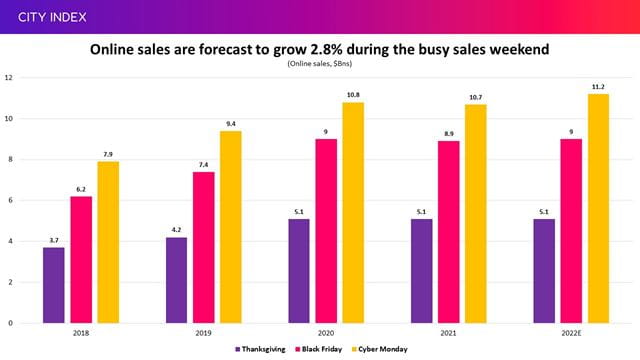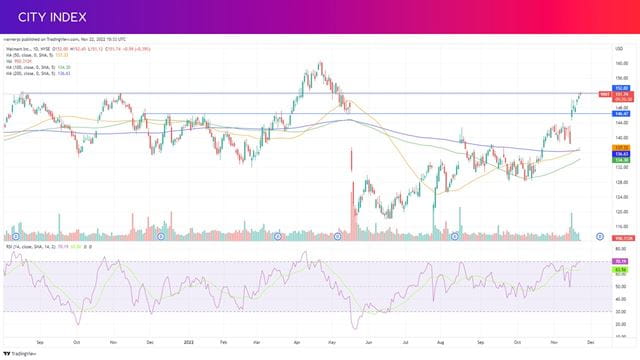
When is Black Friday and Cyber Monday?
This weekend will be a big one for retail as shoppers gear up for the busy sales season, starting on Thanksgiving on November 24 before carrying on into Black Friday on November 25, followed by the weekend and rounded-off by Cyber Monday on November 28.
What to expect from Black Friday and Cyber Monday
It has been an extremely tough year for retailers. Supply chain disruption earlier this year gave way to the eruption of the inflation-fuelled cost-of-living crisis that has squeezed wages and caused drastic shifts in shopping habits. The more being spent on essentials like food, rent and bills leaves less for discretionary goods like general merchandise and electronics. Confidence is also lower with a recession looming around the corner, and consumers need value more than ever. The result, according to Statista Digital Economy Compass, is that global ecommerce sales will fall for the first time on record in 2022, forecasting a 2.5% drop from elevated levels seen in 2021.
This, in turn, has caused huge problems for retailers. In addition to softer overall demand, the rapid change in shopping habits has left retailers with inventory problems. They have too much of the stuff people no longer want and not enough of the products they need. This has meant retailers have had to deliver deeper discounts over a longer period of time than usual in order to shift their unwanted inventory. Stores like Kohl’s and Macy’s launched sales back in October, while ecommerce giant Amazon held a second Prime sales event for the first time ever during the same month. Markets believe the sales events will also continue long past Cyber Monday and into the holiday shopping season.
The problem for retailers is that excess inventory places pressures on costs at a time when they are already rising thanks to inflation, and deep discounts erodes margins and profits. The third quarter earnings season was dire for most US retailers and even the largest and most resilient ones have warned that growth will be sluggish at best in the fourth. US retail sales grew faster than expected last month but this was flattered by people eating and drinking out more and higher fuel prices, with demand for items like electronics, appliances and other general merchandise falling.
Walmart has said it expects sales to grow just 3% in the fourth quarter and that will be largely down to the fact it has large exposure to food, which is still in demand. Amazon has warned growth will stall to its slowest pace on record for any holiday quarter. Target was forced to lower its outlook after failing to offload inventory as fast as it had hoped, while Kohl’s withdrew its guidance altogether.
Black Friday and Cyber Monday online sales to grow 2.8%
The result of the tough environment is expected to be a 2.8% rise in online sales over the weekend, according to Adobe Digital Insights. Sales on Thanksgiving and Black Friday have stalled and are expected to come in-line with what we have seen in the previous two years, leaving Cyber Monday to pick up the slack with estimates pointing toward 4.7% growth from 2021.

(Source: Adobe Digital Insights)
Importantly, these estimates do not include store sales. Although the sales event continues to evolve into a digital one, it is a key period for bricks-and-mortar stores that are still dealing with lower footfall since the start of the pandemic. We should see a much bigger year-on-year improvement here considering Covid-19 was keeping shoppers away from stores in 2021. We have seen multiple US retailers warn that they saw softer demand in late October that continued into November, so the industry will be hoping the event can attract shoppers back to their stores.
What does this mean for retail stocks?
The Black Friday and Cyber Monday sales event kickstarts the Christmas holiday shopping season, which is why the final three months of the calendar year is known as the ‘Golden Quarter’ for sales. The sales event will provide a much-needed boost amid signs that consumer spending is starting to wane, but not enough to salvage what has been a difficult year. Sales growth will be muted, and earnings will remain under pressure.
With this in mind, the key job for retailers like Target or Kohl’s, which have had a tougher time and are still saddled with too much unwanted inventory, is to shift this so they can enter the new year with a clean slate, even if it causes more short-term pain.
Those that have wielded their scale and diversity to adjust inventory at a quicker rate, such as Walmart, could continue to outperform. In fact, while most retailers are forecast to see sales remain under pressure and earnings fall by large double-digit percentages in the fourth quarter, markets believe Walmart has taken a conservative view with its 3% sales growth target and expect its margins to prove far more resilient to allow for a much milder 2.1% fall in adjusted EPS. This is reflected by its premium valuation with a blended price to forward earnings ratio of 23.4x, starkly higher than the 16.5x boasted by its smaller rival Target. Department stores, which have been the worst hit this year, offer significantly lower valuations with Kohl’s trading at 9.4x and Macy’s at just 5.8x.
While the outlook for retail remains tough for the current quarter, markets believe we are past the trough and believe the drop in sales and earnings will moderate going forward. We could see existing headwinds linger into 2023, but markets currently believe it will be a much better period in terms of both sales and earnings next year – although the outlook remains uncertain given the poor economic outlook and looming recession.
Where next for Walmart stock?
Walmart was the standout performer this earnings season, so let’s have a look at how the share price is faring.
The stock has ripped higher since its latest set of results, allowing it to recover much of the ground lost over the past five months. Walmart shares are now at their highest level since May. However, the stock is finding it more difficult to find higher ground from here with the RSI on the cusp of entering overbought territory. It is testing the $152 ceiling we saw in the second half of 2021, which is the immediate upside target.
If it can make a sustained move above here and keep up the momentum, then it can target the 2020-high of $153.60 before eyeing levels near the all-time highs seen back in April. Notably, the 42 brokers that cover the stock have an average target price of $160.30, implying there is limited upside following the recent rally.
This suggests that, in the very short-term, that the risk is to the downside. Renewed pressure is likely to see the stock swiftly fall back toward $146.50, marking the reliable ceiling that held throughout the four months to March. A move below here would bring $143 into play and the 100 and 200-day moving averages that are converging around the $137 mark.

How to trade retail stocks
You can trade a variety of retail stocks with City Index in just four easy steps:
- Open a City Index account, or log-in if you’re already a customer.
- Search for the stock you want to trade in our award-winning platform
- Choose your position and size, and your stop and limit levels
- Place the trade
Or you can practice trading risk-free by signing up for our Demo Trading Account.








